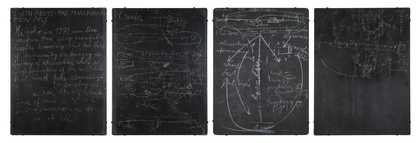Discover how both of the artists in this display used actions to engage the public with social, political and environmental concerns
During the 1970s Beuys developed the role of the artist as teacher. In his actions and exhibitions he outlined theories of creativity and the relationship between art and society. The centrepiece of his Tate exhibition was a performance entitled Information Action. For six and a half hours, Beuys discussed art, politics and the idea of using art as a force for change.
The blackboards shown here were used in Information Action, and in a related event at the Whitechapel Gallery, London. Since the mid-1960s, Beuys had used blackboards in his performances as carriers of information that he could alter as the event progressed. Many of them were preserved as records of his actions. They are now seen as artworks in their own right.
Nicolás García Uriburu wanted to raise awareness about water pollution. At the 1968 Venice Biennale he poured fluorescein into the waters of the Grand Canal. This non-contaminating pigment reacts with micro-organisms in water and turns bright green. In a matter of seconds, the surface of the canal started to change colour. The video Actions in nature captures this brief transformation. Uriburu went on to repeat this action in rivers, coastlines and fountains around the world. It became his best known work.

